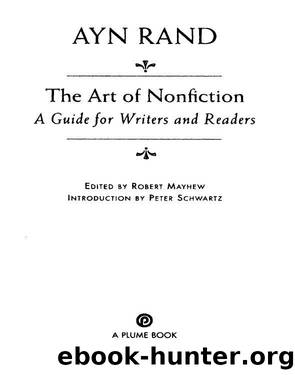The art of nonfiction: a guide for writers and readers by Ayn Rand & Robert Mayhew

Author:Ayn Rand & Robert Mayhew [Ayn Rand & Robert Mayhew]
Language: eng
Format: epub
Tags: Non-fiction
ISBN: 9780452282315
Publisher: Plume
Published: 2001-02-01T21:25:27.429000+00:00
8
Style
Style is a distinctive, characteristic mode of execution. This definition applies to nonfiction writing as well as to all other creative activities, and it encompasses everything pertaining strictly to the form in which ideas are presented.
Style cannot be done to order. This is an absolute. If, when beginning a sentence, you ask whether it is colorful, you will not finish it. Or you will produce one artificial sentence after two hours of work. Style is the result of subconscious integration. You can know in principle how to bring about stylistic trimmings, but you cannot make them to order. Style, therefore, should not be pursued consciously; so many elements are involved that no mind could attend to and integrate all of them. It must be left to your subconscious.
Style in this respect is somewhat similar to emotions. You cannot order yourself to feel (or not feel) an emotion. You cannot control your emotions directly. You can, however, control them indirectly by identifying their root. Emotions are not primaries; they have subconscious intellectual causes. The same is true of style, which comes from a value-integration and must occur spontaneously.
But your subconscious must be free enough to generate style. When writing, if you try to attend simultaneously to your outline, to the content of what you are saying, and to saying it elegantly, your subconscious will be unable to handle it all at once. When what you want to say is clear, however, then spontaneously you will find a way of saying it with a twist. So do not force yourself.
Colorful writing is important. It makes your thought clearer and more dramatic, and therefore has both an intellectual and emotional appeal to the reader. But there is nothing worse than forced colorful writing, e.g., stretched metaphors that do not quite fit the content. The result of forced color is that the reader will mistrust your content, even if you are otherwise logical and honest. Every reader can sense this. He may not be able to tell you why, but he will know something is phony.
The reason why a mannered, artificial style leads to phoniness is implicit in the definition of style. Style is a distinctive, characteristic mode of execution. Characteristic of whom? Obviously, of the writer, or else it is not an individual style. And distinct from what? Obviously, from that of others. But you cannot, by conscious calculation, write in an individual way that is different from that of everybody else.
A fact has been observed in literary circles which nobody can explain (but then these people explain so little): namely, that occasionally a writer appears who has no training, yet writes brilliantly. In the twenties there was a truck driver, with a commensurate type of education, who wrote quite well. I was not fond of what he wrote, but he was successful. What was good about his writing was that it was completely natural. He wrote the way thoughts came to him. That created an inner conviction in his manner of writing. It sounded authentic and original, because he obviously knew no literary rules.
Download
This site does not store any files on its server. We only index and link to content provided by other sites. Please contact the content providers to delete copyright contents if any and email us, we'll remove relevant links or contents immediately.
A New Voyage Round the World by William Dampier(531)
The Negative Trait Thesaurus: A Writer's Guide to Character Flaws by Angela Ackerman Becca Puglisi(521)
Writing Heroes and Villains (A Masterclass in Genre Fiction) by Jackson Dean Chase(481)
The Best American Magazine Writing 2020 by Sid Holt(467)
Animation and Advertising by Unknown(461)
Instagram for Fiction Authors: How to Find Readers, Build Community, and Sell More Books by Sandvig Hanna R(442)
The Positive Trait Thesaurus: A Writer's Guide to Character Attributes by Angela Ackerman Becca Puglisi(440)
Short Fiction by Gustave Flaubert(431)
The Writing Revolution: A Guide to Advancing Thinking Through Writing in All Subjects and Grades by Judith C. Hochman & Natalie Wexler(426)
Write Your Own Script by A.L. Brooks(413)
A Dictionary of Modern English Usage by H. W. Fowler;David Crystal;(397)
How to Write a KILLER LinkedIn Profile... And 18 Mistakes to Avoid: Updated for 2019 (14th Edition) by Brenda Bernstein(389)
The Best American Travel Writing 2020 by Jason Wilson(384)
The Craft of Writing Science Fiction that Sells by Ben Bova(379)
Instagram for Fiction Authors: How to Find Readers, Build Community, and Sell More Books by Hanna R. Sandvig(371)
Writer's Craft Power Pack 2: Five-Book Bundle for Authors by Rayne Hall(370)
Baudelaire and Photography by Raser Timothy;(356)
5 Steps to a 5: Writing the AP English Essay 2021 by Barbara Murphy(353)
News and How to Use It by Alan Rusbridger(350)
